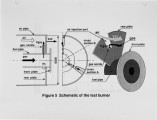| OCR Text |
Show sufficiently entrained into the combustion air and the fuel gas before the combustion initiates, thereby maximizing the effect of self-induced EGR. 5. Application to Full-scale Boiler The generic lifted flame burner was applied to a full-scale boiler with steam generation of 2.4 ton/hour at a fuel input 1.6 MW. The burner was scaled-up to furnish a shell-and-tube boiler, 1900 mm long and 900 mm diameter. Combustion air was preheated to 373K (100'C). Figure 16 shows the effect of excess air ratio on NOx and CO with three levels of fuel input NOx emission of as low as 20 ppm (0% 0) was achieved at fuel input Ip of 1.4 MW and excess air ratio A of 1.1 without CO emission. The results confirmed the substantially low NOx and CO emissions achieved in the experimental furnace. Lifted flames were proven to be applicable to the full-scale boiler as a novel low NOx combustion technique. 6. Conclusion Lifted flames were proven to have a high potential for low NOx combustion. The lifted flame entrained a large amount of flue gas into the combustion air before combustion initiated. Substantial NOx reduction was achieved without CO emission by maximizing the effect of self-induced flue gas recirculation. Utilizing the lifted flames, low NOx emission as low as 20 ppm (0% 0) was achieved in a full-scale boiler. Application of lifted flame combustion to a wide variety of combustion equipment is now being implemented, and low NOx burners based on this study will be developed. 7. References (1) E. Shigeta, H. Kanazawa, T. Koizumi, and T. Nagata "Low NOx Combustion Technique for High Temperature Furnace", Proc. of AFRC/JFRC Int. Conf. on Environmental Control of Comb. Processes (1991) (2) IFRF Doc no. F/037/a/15 (1986) |























